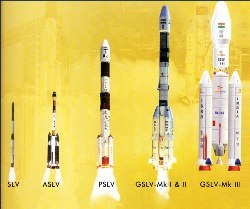Launch Vehicles are used to transport and put satellites or spacecrafts into space. In India, the launch vehicles development programme began in the early 1970s. The first experimental Satellite Launch Vehicle (SLV-3) was developed in 1980. An Augmented version of this, ASLV, was launched successfully in 1992. India has made tremendous strides in launch vehicle technology to achieve self-reliance in satellite launch vehicle programme with the operationalisation of Polar Satellite Launch Vehicle (PSLV) and Geosynchronous Satellite Launch Vehicle (GSLV).
PSLV represents ISRO's first attempt to design and develop an operational vehicle that can be used to orbit application satellites. While SLV-3 secured for India a place in the community of space-faring nations, the ASLV provided the rites of passage into launch vehicle technology for ISRO. And with PSLV, a new world-class vehicle has arrived. PSLV has repeatedly proved its reliability and versatility by launching 48 satellites / spacecrafts ( 22 Indian and 26 Foreign Satellites) into a variety of orbits so far.
PSLV
The Polar Satellite Launch Vehicle,usually known by its abbreviation PSLV is the first operational launch vehicle of ISRO. PSLV is capable of launching 1600 kg satellites in 620 km sun-synchronous polar orbit and 1050 kg satellite in geo-synchronous transfer orbit.The reliability rate of PSLV has been superb. There had been 18 continuously successful flights of PSLV, till July 2011 . With its variant configurations, PSLV has proved its multi-payload, multi-mission capability in a single launch and its geosynchronous launch capability. PSLV vechicles : PSLV D1 to PSLV D3.(In this D1 failed with IRS-1E in 1993) and PSLV C1 to C17 (In this PSLV-C11 launched CHANDRAYAAN-I, also number 13 is a bad one for ISRO too!!)
GSLV-I&II
Geosynchronous Satellite Launch Vehicle(GSLV)-Mark I&II ,is capable of placing INSAT–II class of satellites (2000 – 2,500 kg) into Geosynchronous Transfer Orbit (GTO). GSLV is a three stage vehicle GSLV is 49 m tall, with 414 t lift off weight. It has a maximum diameter of 3.4 m at the payload fairing. The first flight of GSLV took place from SHAR on April 18, 2001 by launching 1540 kg GSAT-1. It was followed by six more launches , GSLV-D2 on May 8, 2003 (GSAT-2 1825 kg), GSLV-F01 on September 20, 2004 (EDUSAT 1950 kg), GSLV-F02 on July 10, 2006 (failed), GSLV-F04 on September 2, 2007 (INSAT-4CR 2130 kg), GSLV-D3 on April 15, 2010 (failed) and GSLV-F06 on December 25, 2010 (failed).
GSLV-III
Geosynchronous Satellite Launch Vehicle Mark III, is a launch vehicle currently under development by the Indian Space Research Organization. GSLV Mk III is conceived and designed to make ISRO fully self reliant in launching heavier communication satellites of INSAT-4 class, which weigh 4500 to 5000 kg. It would also enhance the capability of the country to be a competitive player in the multimillion dollar commercial launch market. The vehicle envisages multi-mission launch capability for GTO, LEO, Polar and intermediate circular orbits. The development work on Mk III is progressing as per schedule for a launch in 2012.
Latest News on Satellite Launch Vehicles of India
15 July,2011 : PSLV-17 Launches GSAT-12 Successfully from Sriharikota
source : www.isro.org
source : www.isro.org






0 comments: